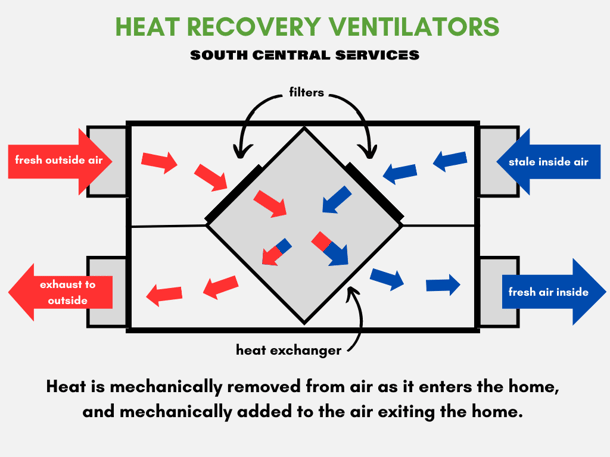The All-Inclusive Overview to the Uses of Heat Recovery Ventilation in Modern Buildings
Heat Recovery Ventilation (HRV) systems stand for a substantial improvement in building modern technology (HRV Heat Recovery Ventilation). They offer an approach for exchanging stagnant interior air with fresh outside air while lessening energy loss. This strategy not only enhances indoor air high quality but additionally adds to energy performance in both domestic and business buildings. Comprehending the numerous applications and benefits of HRV can expose its essential function in modern-day design and sustainability initiatives. The implications of this innovation deserve exploring additionally
Recognizing Heat Recovery Ventilation Systems

Although several modern buildings focus on power efficiency, comprehending warm recuperation air flow (HRV) systems is vital for enhancing interior air top quality and lowering energy consumption. HRV systems work by transferring warmth from stagnant interior air to inbound fresh air, successfully keeping comfy interior temperature levels while lessening energy loss. These systems include a warm exchanger, fans, and ductwork that help with the blood circulation of air. Throughout winter, HRV units record and recycle heat from the outward bound air, while in summertime, they can help cool incoming air. By continuously trading air, HRV systems likewise reduce moisture and the focus of interior contaminants. Appropriate installation and upkeep of HRV systems are vital for their effectiveness and effectiveness in enhancing total building performance and convenience.
Benefits of Heat Recovery Ventilation
Heat recovery ventilation systems offer many benefits that boost both power effectiveness and indoor air high quality in contemporary buildings. By capturing and reusing energy from exhaust air, these systems significantly reduce cooling and heating prices, causing reduced power usage. They keep a constant circulation of fresh exterior air, reducing the threat of indoor air toxins and allergens. This continual exchange aids regulate moisture degrees, preventing mold and mildew growth and guaranteeing a much healthier living atmosphere. In addition, HRV systems contribute to sustainability objectives by decreasing general carbon footprints. Their ability to enhance air flow without sacrificing thermal comfort makes them a valuable addition to modern building style, advertising both economic and ecological benefits.
Applications of HRV in Residential Structures
As homeowners progressively focus on energy effectiveness and interior air top quality, the applications of warm recuperation ventilation (HRV) systems in property structures have become a lot more widespread. HRV systems are specifically advantageous in securely sealed homes, where maintaining fresh air flow is necessary for stopping moisture buildup and Read Full Report indoor contaminants. They successfully move warmth from outbound stale air to inbound fresh air, reducing energy prices related to heating & cooling. Additionally, HRVs can boost comfort degrees by managing humidity and temperature level. They are likewise versatile for various residential styles, including single-family homes and multi-unit structures. In general, integrating HRV systems supports sustainable living methods while making certain a much healthier interior setting for occupants.
HRV in Industrial and Commercial Setups
In industrial and commercial setups, the application of heat recovery air flow (HRV) systems has actually become increasingly important for maximizing power efficiency and keeping air quality. These systems efficiently transfer warmth from exhaust air to inbound fresh air, lowering the requirement for additional home heating or air conditioning. This not only lowers power expenses however likewise adds to sustainability campaigns. Industries such as production, warehousing, and office buildings benefit greatly from HRV systems, as they aid control temperature and humidity levels, making certain a comfortable and productive setting. HRV systems aid in removing pollutants and excess moisture, boosting indoor air quality. As policies around air top quality end up being stricter, the adoption of HRV technology is likely to expand, making it a critical element of modern industrial and commercial infrastructure.
Future Trends in Heat Recovery Ventilation Modern Technology

Regularly Asked Questions
Just How Does Heat Recovery Ventilation Impact Indoor Air Top Quality?
Heat recovery ventilation greatly enhances interior air quality by continuously exchanging stale indoor air with fresh outside air while recuperating energy. This procedure decreases toxins, keeps ideal humidity degrees, and ensures a healthier atmosphere for owners.
Can HRV Solutions Be Mounted in Existing Buildings?
HRV systems can indeed be mounted in existing buildings. Retrofitting may need alterations to ductwork and air flow layouts, yet it considerably enhances power effectiveness and indoor air top quality, making it a viable choice for Web Site older frameworks.
What Upkeep Is Required for HRV Equipments?

Exist Details Climates Where HRV Is Extra Reliable?
Heat recovery ventilation systems are especially effective in environments with considerable temperature level differences between periods. These systems optimize power efficiency by recouping warmth from exhaust air, making them ideal for both cool and reasonably warm atmospheres.
How Do HRV Equipments Affect Energy Expenses?
